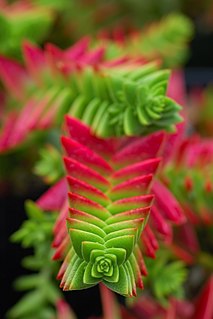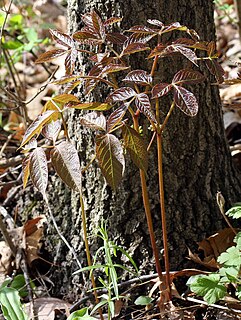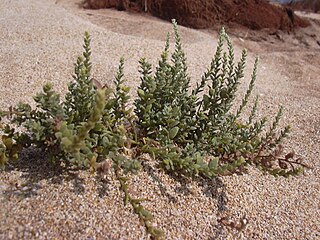
Crassula is a genus of succulent plants containing about 200 accepted species, including the popular jade plant. They are members of the stonecrop family (Crassulaceae) and are native to many parts of the globe, but cultivated varieties originate almost exclusively from species from the Eastern Cape of South Africa.

The Gomphrenoideae are a subfamily of the Amaranthaceae.

Globularia is a genus of about 22 species of flowering plants in the family Plantaginaceae, native to central and southern Europe, Macaronesia, northwest Africa and southwest Asia. They are dense low evergreen mat-forming perennials or subshrubs, with leathery oval leaves 1–10 cm long. The flowers are produced in dense inflorescences (capitula) held above the plant on a 1–30 cm tall stem; the capitula is 1–3 cm in diameter, with numerous tightly packed purple, violet, pink or white flowers.

A least-concern species is a species that has been categorized by the International Union for Conservation of Nature (IUCN) as evaluated as not being a focus of species conservation because the specific species is still plentiful in the wild. They do not qualify as threatened, near threatened, or conservation dependent.

Aralia nudicaulis is a flowering plant of northern and eastern North America which reaches a height of 30–60 cm (12–24 in) with creeping underground stems.

Aechmea nudicaulis is a bromeliad species in the genus Aechmea, which is often used as an ornamental plant. This species is native to Central America, the West Indies, central and southern Mexico, and northern and central South America.
Froelichiella is a genus of Brazilian plants in the family Amaranthaceae. It is sometimes included in the genus Froelichia or family Chenopodiaceae.
Many species of wildflowers are native to New England. There are four important community types which show considerable diversity and blending across this United States physiographic region. These are: alpine, coniferous forests, northern hardwood forests, and wetlands. Wetlands may be further subdivided into bogs, swamps, and bottomlands. This article lists some of these Wildflowers of New England and references sites for further research.

Day's shrew is a species of mammal in the family Soricidae. It is endemic to India. Its natural habitat is subtropical or tropical dry forests. It is threatened by habitat loss.

Froelichia, or snakecotton, is a genus of plants in the family Amaranthaceae.
Jatropha nudicaulis is a species of plant in the family Euphorbiaceae. It is endemic to Ecuador. Its natural habitat is subtropical or tropical dry shrubland.

Rugelia nudicaulis, the sole species of the genus Rugelia, blooms in summer. It is a wildflower endemic to higher elevations in the Great Smoky Mountains. It is a rare species in Tennessee. First placed in the genus Senecio, then moved to Cacalia it was finally placed in a genus of its own, Rugelia. Genetic diversity in this plant, assessed using allozymes, is so low that the species may not survive changing environmental conditions.

Cressa is a genus of plants in the morning glory family known generally as alkaliweeds. These plants are native to the tropical and subtropical areas of the world. They are clumpy and low-growing but usually have erect stems covered white-haired, green leaves. They produce tiny white flowers about half a centimeter across.

Enceliopsis nudicaulis is a North American species of flowering plants in the daisy family known by the common name nakedstem sunray, or naked-stemmed daisy.
F. gracilis may refer to:

The World's 25 Most Endangered Primates is a list of highly endangered primate species selected and published by the International Union for Conservation of Nature (IUCN) Species Survival Commission (SSC) Primate Specialist Group (PSG), the International Primatological Society (IPS), Global Wildlife Conservation (GWC), and Bristol Zoological Society (BZS). The IUCN/SSC PSG worked with Conservation International (CI) to start the list in 2000, but in 2002, during the 19th Congress of the International Primatological Society, primatologists reviewed and debated the list, resulting in the 2002–2004 revision and the endorsement of the IPS. The publication was a joint project between the three conservation organizations until the 2012–2014 list when BZS was added as a publisher. The 2018–2020 list was the first time Conservation International was not among the publishers, replaced instead by GWC. The list has been revised every two years following the biannual Congress of the IPS. Starting with the 2004–2006 report, the title changed to "Primates in Peril: The World's 25 Most Endangered Primates". That same year, the list began to provide information about each species, including their conservation status and the threats they face in the wild. The species text is written in collaboration with experts from the field, with 60 people contributing to the 2006–2008 report and 85 people contributing to the 2008–2010 report. The 2004–2006 and 2006–2008 reports were published in the IUCN/SSC PSG journal Primate Conservation,, since then they have been published as independent publications.
Froelichia juncea is a plant species native to the Galápagos Islands of Ecuador. There are two subspecies of F. juncea: F. juncea subsp. juncea and F. juncea subsp. alata. F. juncea subsp. alata was first described by Thomas J. Howell.

Crassula nudicaulis is a succulent plant native to South Africa, and Lesotho.

Froelichia floridana is a species of flowering plant in the genus Froelichia, in the amaranth family (Amaranthaceae). It is known as prairie cottonweed, Florida snakecotton, large cottonweed, field snakecotton, or plains snakecotton. An annual, it produces white woolly flowers on tall flowering stalks, growing up to 40 in (1,000 mm) in height. The narrowly oblanceolate to elliptic leaves are opposite, occurring on the lower third of the stem. It grows in central and eastern North America, from the Great Plains to Mexico, east to the Atlantic Coast. Its propensity to spread easily has resulted in it being considered an agricultural weed and it is an invasive species in Australia.













